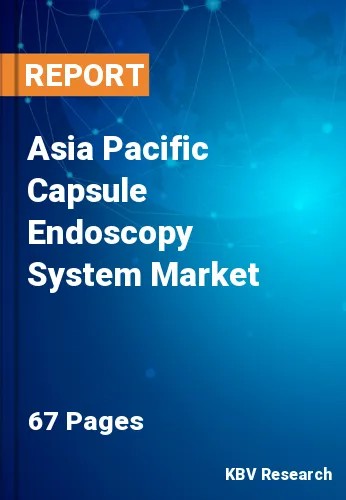The Asia Pacific Capsule Endoscopy System Market would witness market growth of 12.6% CAGR during the forecast period (2022-2028).
Traditional endoscopy's diagnostic, monitoring, and visualization qualities have all been enhanced owing to technological advancements. Newer varieties of capsule endoscopes, such as small bowel capsule endoscopes, colon capsule endoscopes, and esophageal capsule endoscopes, have been developed as a result of advanced technologies. Endoscopy now has a high level of accuracy, safety, and precision that would have been impossible to attain just a few years ago.
The market for capsule endoscopy systems is expected to grow significantly over the forecast period, owing to an increase in demand for minimally invasive diagnostic procedures. Increased cancer prevalence, an increase in the senior population, and a surge in the introduction of technologically improved capsules are among the primary drivers driving market expansion.
The external shell, optical window, LED array, optical lens, CMOS image sensor, radio frequency transmitter, antenna, and a power source are all included in a standard capsule endoscope. The exterior shell and optical window are the endoscope's outermost components. Light from the embedded LEDs illuminates the nearby area through the optical window. The exterior casing keeps any possibly harmful physiological fluids away from the electrical components. An array of LEDs is placed around the camera lens inside the capsule. The number of LEDs varies depending on the type, however, it is usually between 4 and
Asia Pacific region is experiencing increased demand for capsule-based endoscopic technology for screening operations. In addition, improving healthcare infrastructure and a growing senior population are two significant factors driving growth. Furthermore, one of the pioneering aspects responsible for attracting international investments is strong economic development in the region. The presence of large competitors, as well as the rapidly evolving start-up scene, is boosting the market growth.
Japan's healthcare system is well-developed, with universal health insurance coverage for all citizens. Japan spends more than most countries on healthcare per citizen. As a result, everyone can afford to receive healthcare services. Innovative technologies, such as capsule endoscopy devices, are quickly adopted in a well-developed healthcare system. Japan is also one of the world’s largest medical device markets. New and innovative healthcare technologies are adopted quickly in this country. This is good news for the capsule endoscopy system market.
The China market dominated the Asia Pacific Capsule Endoscopy System Market by Country in 2021, and would continue to be a dominant market till 2028; thereby, achieving a market value of $114.5 million by 2028. The Japan market is anticipated to grow at a CAGR of 12% during (2022 - 2028). Additionally, The India market would experience a CAGR of 13.3% during (2022 - 2028).
Based on Component, the market is segmented into Capsule Endoscope and Work-stations & Recorders. Based on Disease Type, the market is segmented into Small Intestine Disorder, Esophageal Disorder, and Colonic Disorder. Based on countries, the market is segmented into China, Japan, India, South Korea, Singapore, Malaysia, and Rest of Asia Pacific.
Free Valuable Insights: The Worldwide Capsule Endoscopy System Market is Projected to reach USD 1.4 Billion by 2028, at a CAGR of 12.1%
The market research report covers the analysis of key stake holders of the market. Key companies profiled in the report include Fujifilm Holdings Corporation, Medtronic PLC, Olympus Corporation, Check Cap Ltd., CapsoVision, Inc., Chongqing Jinshan Science and Technology Group Co., Ltd., IntroMedic Co., Ltd., RF Systems Lab, Shangxian Minimal Invasive, Inc., and AnX Robotica Corp.
By Component
By Disease Type
By Country
Our team of dedicated experts can provide you with attractive expansion opportunities for your business.

